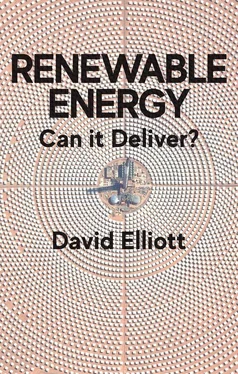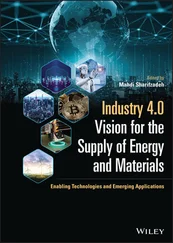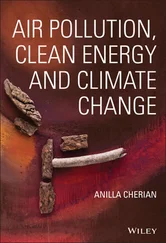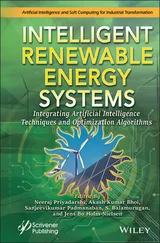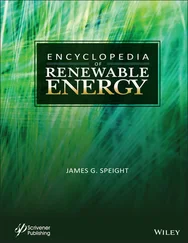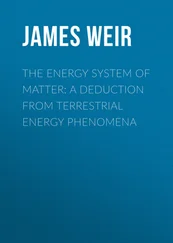While most renewables have generally low, or even negligible, global environmental/climate impacts, some can have significant local impacts, large hydro in particular. For most other renewables (including small hydro), there are technical options that can reduce local operational impacts on wildlife, such as acoustic bird-scaring systems for wind turbines, and there are also ways to avoid or reduce local social impacts by careful design, siting and operation. Although there are areas of marginal land that can be used, biomass is probably the worst offender in terms of land use. Growing biomass energy crops is inevitably land using. That is one reason why there is now more interest in using biomass in the form of farm and food wastes since that already exists: using it can be part of a move to a lower-impact circular economy. In terms of climate impacts, since the CO 2produced when biomass is burnt is re-absorbed when plants grow, biomass can in theory be near carbon balanced if the rate of use is matched by the rate of replanting. Nevertheless, as I will be illustrating, although it can be a renewed resource, the use of biomass as an energy source may have eco-impacts, depending on the type of biomass and its pattern of production and use.
There is also the obvious, more general point that there is a need to balance the variable outputs from renewables like wind and solar, the cost of this often being presented as a ‘killer argument’ against them. However, as I will be exploring in detail in subsequent chapters, it is not an insuperable problem. The grid system already handles variations in supply and demand and can be upgraded to continue to do that as more renewables are added, although it may take time to develop and deploy some of the new technologies that will be needed, including storage capacity. The extra cost of grid balancing has been put at maybe 10–15%, or perhaps less, if the proper measures are adopted (Heptonstall, Gross and Steiner 2017): some of the new grid-balancing measures may reduce system costs by matching energy supply and demand better, thus improving overall system efficiency (ICL/Ovo 2018).
A more substantial issue is that there will be a need to supply heat and transport energy as well as electricity, a somewhat harder task. Nevertheless, as I explain below, it can be done, although to understand how, and to get to grips with the full transition costs, we need to start looking at the energy system as a whole, not at individual components. Making system-wide changes may be hard and, although the commercial incentives to move ahead are now stronger, they may not be sufficient to accelerate renewable expansion and system change fast enough to deal with the urgent climate and pollution problems. So there may be a need for extra support from governments, for example via subsidies to enable accelerated programmes of development and deployment. That has certainly been the lesson so far: markets on their own have not been sufficient. The point may soon be reached when subsidies will no longer be needed, at least for the initial wave of renewables, but clearly there will be cost implications and political choices associated with making the energy transition (Carbon Tracker 2019). They are what this book aims to explore.
Policy change – the costs of the transition
In the short term, some say, the changeover to renewables may incur extra costs, perhaps, according to one EU-focused study, adding up to 30% to the total-system cost (Zappa, Junginger and den Broek 2019). However, that view has been disputed in the case of the European Union (EU) (Beam 2019) and is also challenged in many of the global ‘high renewables’ scenarios that have emerged. Instead, it is argued that, as the new system develops, direct and indirect costs should fall since there would be no use of increasingly expensive fossil fuels, and the social and environmental costs of their use would be avoided. As renewable costs continue to fall, and climate threats rise, that view does seem attractive.
Nevertheless, a big political issue in the interim is whether the falling cost of renewables will ensure that the cost of their rapid expansion will avoid a backlash from consumers. The implementation/support costs certainly have been a problem. As a result, some expansion programme slowdowns have been imposed (across the EU and also in China), ostensibly on the basis of fears about the rising costs of support schemes. These cutbacks have been buttressed by the rise of populist backlashes from those who feel they have been left out or left behind in social and economic terms, which has added a new political dimension and feeding back, around the world, into reaction against ostensibly progressive change (O’Neill 2018). In parallel, in relation to the cost of energy transitions there have been warnings, from otherwise divergent camps, about the need for ‘energy justice’ (Monyei et al. 2018) and the risk of increased fuel poverty (Beisner 2019).
While there are certainly social equity issues to be addressed (McGee and Greiner 2019; Sovacool 2013), and I will look at them later, there are also wider strategic energy perspectives which may present challenges to renewables, such as the belief that other options would be better and cheaper, for example nuclear and fossil carbon capture (Aris 2018).
Technically, the renewables case is strong. The International Renewable Energy Agency (IRENA) claims that renewable energy, along with energy efficiency, can provide more than 90% of the necessary energy-related CO 2emissions reductions (IRENA 2018). The economic impact case is also good: despite fears about the cost of the energy transition, it may not in fact cost consumers too much. The European Commission (EC) says that, under its proposed renewables-led transition, ‘by 2050, households would spend 5.6% of income on energy-related expenses, i.e. nearly 2 percentage points lower than in 2015 and lower than the share in 2005’ (EC 2018). However, that is speculative, and the EC does include more than just renewables in its proposed mix, as do some other studies. Indeed, although most agree that renewables will boom, some see fossil fuel, and possibly nuclear, remaining as a vital part of the energy mix into the far future (BP 2019; WEC 2019).
So the question remains: are they right, or can the renewables meet all our energy needs? That may depend on what sort of future global energy system and economy we are looking to create, how rapidly the changes can be made and how we go about making them, issues explored in subsequent chapters.
The first part of the book focuses on the technological aspects, starting off, in chapter 2, with an overview of the technological options and key related transition issues. Chapter 3then looks at what energy supply technology choices have been made in some of the existing future-energy scenarios, while chapter 4looks at system integration and balancing requirements and options.
The second part of the book moves on from essentially technologically defined issues and options to an exploration of the wider strategic issues and choices, including social change options, asking whether we can and should move to a low- or zero-growth sustainable energy future. Chapter 5looks at the issue of growth, and at the need for a socially equitable transition process, while chapter 6focuses on the wider geopolitics of the transition. Chapter 7looks at some examples of what is happening around the world, leading to an overall conclusion in chapter 8.
Energy metrics and climate impacts – a short guide
The emphasis in this book is on energy policy, in particular the technological choices ahead. I have tried to use plain English and avoid technical terms but, inevitably, getting on top of what is a complex field requires some understanding of basic energy systems and technology and related issues. Box 1.3 provides a short guide to the measurement units used in this book. Perhaps surprisingly, not all of the metrics used are uncontroversial.
Читать дальше
